The history of the Iraqi Navy. Part of 2. Iran-Iraq War at Sea (1980-1988)
The Iranian fleet had 3 destroyers (1 former English type Batlle - Damavand, w / D5; Babr, w / D7, Palang, w / D9, American type Allen M. Sumner since World War II), 4 frigate (English Vosper Mk.5); 4 Corvette (American Bayandor); 12 missile boats (French type Combattante II with US RGM-84A "Harpoon"; 4 TDK, 3 BST, 2 RTSS and around 100 of various boats. That is, the Iranian Navy was completely superior to the Iraqi Navy, and it must also be taken into account that the Iranians did not have time to get the Kidd-type 4 missile destroyers ordered in the US.
Given such a sad state of affairs, the Iraqis did not even try to actively act at sea. However, there were several naval battles, the most famous of which was Operation Morvarid (Persian Pearl), an Iranian strike operation fleet and the Air Force off the coast of Iraq on November 28, 1980.
The attack was in response to the deployment by Iraq of advanced observation posts and radar stations on oil platforms in the bay. November 28, 1980 Iranian aviation dealt a powerful blow to the Iraqi airfields around Basra. F-5 Tiger fighters and F-4 Phantom II fighter-bombers took part in the raid. The raid was a success, the airways were damaged, in addition, one MiG-21 fighter was destroyed on the ground. This operation weakened the air presence of Iraq over the eastern part of the Persian Gulf and facilitated the operation of the naval forces.
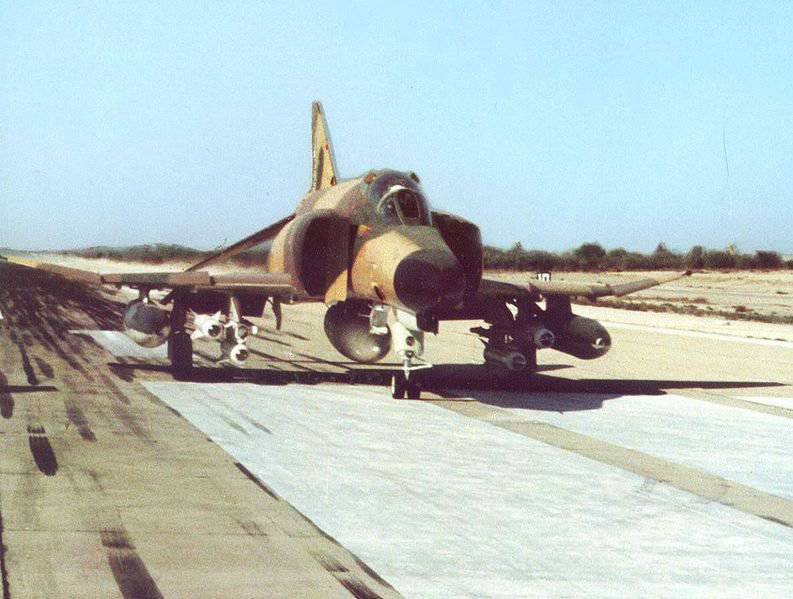
F-4D Phantom II fighter-bomber of Iranian air force with AGM-65 Maverick missiles preparing for combat mission
On the night from 28 to 29 in November, six ships of the Iranian fleet, connected to the 421 Task Force, secretly approached the Iraqi coast and, with the support of deck and base helicopters, landed commandoes at Iraq’s Mina al-Bakr and Qor al-Amia oil terminals. The attack was completely unexpected for the Iraqis. After a short firefight, Iranian soldiers put down resistance from the defenders, and, laying down explosive charges, were evacuated by Boeing CH-47 Chinook helicopters. The terminals and nearby radar early warning stations were completely destroyed, and heavy damage was caused to Iraq’s oil infrastructure.
At the same time, two Iranian missile boats Paykan and Dzhoshan of the French type La Combattante II with a displacement of about 265 tons, armed with 4 PU GCR RGM-84A Garpun, 1 76-mm AU OTO Melara and 1 40-X AU Breda-Bofors each blocked the Iraqi ports of Al-Fau and Umm-Qasr.

More than 60 foreign ships were locked in ports, unable to sail. Also Iranian missile boats subjected both ports to shelling, causing some damage to the infrastructure.
On the morning of November 29, two groups (four each) of the Iraqi torpedo boats of the 183 project and a detachment of 5 missile boats of the 205 project took to sea to counterattack Iranian ships from Al-Faw.
Having found the enemy, both sides exchanged missile strikes. The Iranians were the first to strike, taking advantage of the RGM-84A Garpun long-range capability. Two Iraqi missile boats were sunk by the Harpoon hits, but the other three continued their attack on the Peikan missile boat.
Once under attack by superior enemy forces, the Iranian missile boat requested the support of its air force. The Iranian Air Forces responded to a request for help, sending the Phantom X-FN to the X-NUMX F-2 from Bushehr airbase. However, by the time they arrived, the Peikan was already hit by two P-4 Termite missiles and was sinking. In retaliation for the death of their rocket boat, the Phantoms immediately attacked the Iraqi compound with AGM-15 "Hellfire" missiles, causing him catastrophic damage: 114 torpedo boats of the 4 project were sunk, 183 2 missile boats were disabled and another Iraqi missile the boat was literally torn to pieces by the simultaneous hit of 205 missiles. The almost complete destruction of the Iraqi compound took less than 3 minutes.
At the same time, the X-NUMX of the Phantom II F-4 fighter from the Shiraz airbase bombed the port of Al-Fau, using controlled bombs to destroy port warehouses and infrastructure. The attack was supported by the F-4 Tiger link, which bombarded air defense positions around the port. The Iraqi air defense acted ineptly and could not prevent the destruction of the port: one Iranian fighter, according to Iraq, was shot down by MANPADS, but managed to get to the base.
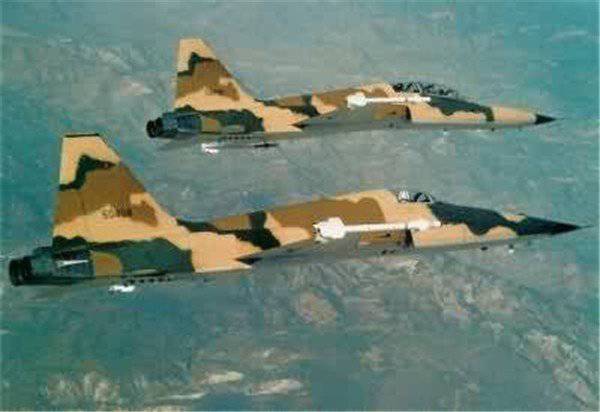
At the same time, the new forces of Iranian aviation — the F-5 Tiger fighters and the Tomcat F-14 interceptors — arrived in the eastern part of the Persian Gulf, covering the retreat of the fleet and supporting F-4, striking ports and oil rigs. At the same time, the SAF.321H Super Frelon helicopter, which took off from one of the towers, was equipped with Exochet missiles to attack retreating Iranian ships, was attacked by laser-guided missiles and destroyed in the air.

Finally, the Iraqi aircraft appeared on the battlefield. Two links of the MiG-23 fighters rose from air bases and engaged in battle with Iranian aircraft. Iranian F-4 "Phantom II", already freed from the bomb load, entered the battle. In just a few minutes of the 3 air battle, the Iraqi MiG-23 were shot down at the cost of losing one Phantom. Another four of the MiG-23 attempted to attack the Joshan missile boat retreating to the east, but was forced to retreat, losing the plane from a MANPADS shot from the boat. Following this, the patrolling Iranian F-14 "Tomcat" attacked Iraqi aircraft, knocking down two of them and forcing the remaining MiG to retreat.

Operation Morvared ended with the undoubted success of the Iranian forces and a heavy defeat for Iraq. In less than 12 hours, the 80 percent of the Iraqi fleet (including 5 missile boats) were destroyed, the oil terminals of Mina al-Bakr and Qor al-Amiya were destroyed by a commando attack, the port of Al-Faw was blocked and bombarded. In total, during the operation, Iraq lost 5 missile boats, 4 torpedo boats, SA.321H attack helicopter "Super Frelon", one MiG-21 fighter (bombed out on the flight strip) and 4 MiG-23 fighter. In addition, the radar systems were destroyed, which violated Iraqi control over the airspace of the Persian Gulf.

The losses of the Iranians were much less: they lost one rocket boat (Peykan) to the sunk, one F-4 fighter-bomber Phantom II shot down and one damaged.
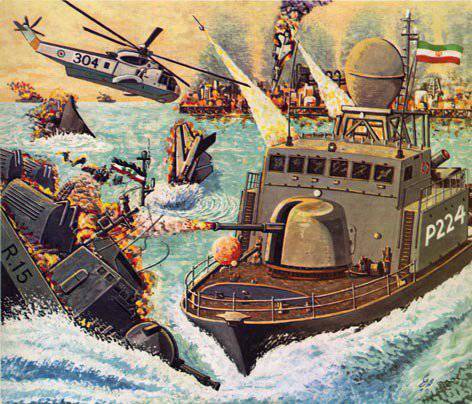
The second Iranian rocket boat Joshan was subsequently sunk in 1988 during the Mantis operation by the American frigate Simpson, firing two SM-1MR anti-aircraft missiles that destroyed its superstructure, using the Wainwright missile cruiser, which fired another missile The SM-1ER, which hit the hull and destroyed almost the entire crew of the boat, and the frigate "Badley", which launched the anti-ship missile RGM-86 "Harpoon". He didn’t succeed in getting hit - the Iranian ship’s superstructures were almost completely destroyed by the SM-1 missiles, and the silhouette of the boat was almost hidden in the waves. After that, not wanting to spend more missiles, the American ships approached the rocket boat and finished it off with artillery fire. Together with "Joshan", his entire team perished.
Currently, the names of Peikan and Dzhoshan and on-board numbers (P 224 and P 225) are new Iranian-built rocket boats of the Sina type based on the Caspian Sea.
In the same November 1980, the blow of the Iranian "Phantoms" was also sunk by KFOR of the 773 "Janada" project (b / n 74).
Having suffered such heavy losses, the Iraqis urgently began to search for the source of their replacement. And their choice fell again on Yugoslavia.
In 1980, in Yugoslavia, an 3 river minesweeper "MS 25" of the Nestin type was built by order of Iraq. Displacement: standard 57,31 / full 72,3 t. Length: 26,94 m, width: 6,48 m, draft: 1,08 m. Full speed: 13,5 knots. Navigation range: 860 miles at speeds of 11 knots. Powerplant: 2х260 hp, diesel Torpedo B539 RM 79. 1, 4, 20, 75, 2, 1, 20, 71, 1, 4 mechanical trawl MDL-4R, pontoon electro-acoustic trawl PEAM-2A, acoustic explosive trawl AEL-18. RTV: Decca 82 navigation radar. Crew: 24 people. (including 1 of.).
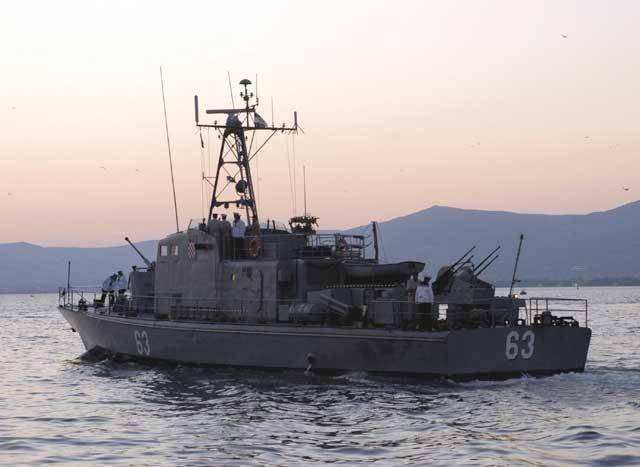
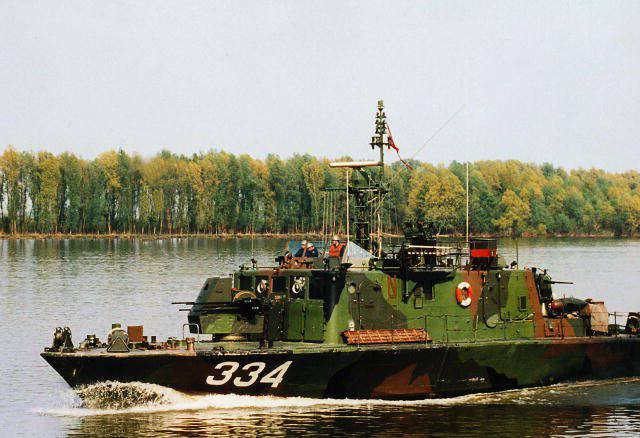
In 1981, the Iraqis ordered the 3 tank landing craft of the Al Zahra type (Al-Zahra) in Finland disguised as cargo rollers received in 1983 in Finland. At the same time in the UK, Iraqis ordered 6 airborne assault boats of the SR.№6 type. The British fulfilled the order for the year, thanks to which the ability of the Iraqi Navy to carry out tactical-scale amphibious operations was completely equal to the Iranian Navy, for which the second brigade of the Marine Corps was formed in 1986 in the Republican Guard. Displacement - 15 t. Length - 18,5 m, width - 7,7 m. Power GTU - 1400 l. with. Speed - 50 knots Sailing Range - 200 miles. Roof mounted armament included an 7,62-mm or 12,7-mm machine gun. The maximum payload is 5-6 tons of cargo or up to 55 fully equipped soldiers.
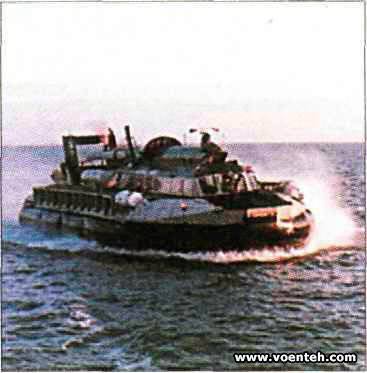
Also, in order to compensate for the losses of February 1983, the Soviet Union Tamuz (b / n 17) of the 205 project was supplied from the USSR.
In 1984-1985. In Yugoslavia, 15 patrol ships of the PB 90 type were built. Displacement: standard 85 / full 90 t. Length - 27,3 m, width - 5,9 m, draft - 3,1 m. Full speed - 31 knots. Cruising range - 800 miles at speed 20 nodes. Autonomy - 5 days. The power plant - 3x1430 hp, diesel. Armament: 1X1 40 mm AU Bofors L / 70, 1x4 20 mm AU M 75, 2x2 PU 128-mm Svitac lighting flares. RTV: Decca RM 1226 navigation radar. Crew: 17 people.
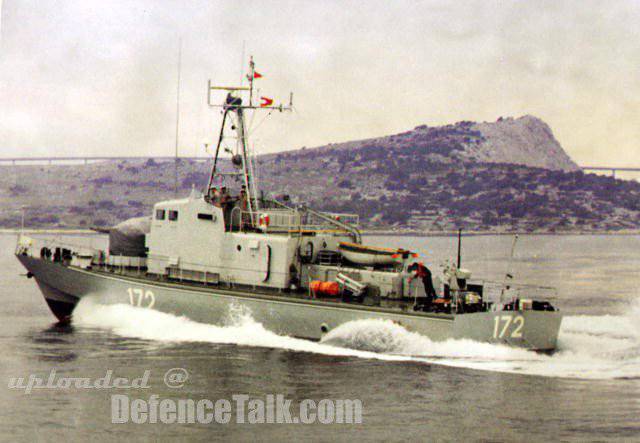
The fight against the Iranian Navy was entrusted to the Iraqi Air Force.
Initially, the Soviet Union used heavy bombers Tu-16 (12 units) with anti-ship missiles KSR-2.

So, 17.11.1983, an Iraqi Tu-16, attacked the former Italian Atlantic liner Rafaello, used by Iranians as a floating barrack, with an anti-ship missile DAC-2 in the port of Bushehr. The ship caught fire and completely burned out, and was subsequently withdrawn from the port by the Iranians and scuttled (however, according to other sources, it was a heavy SA.321H French helicopter with the anti-ship missile AM.39 Ekzosett).
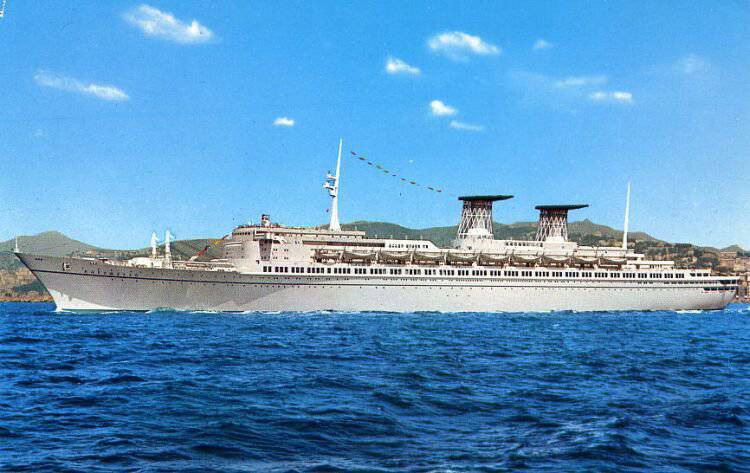
Iraqis were not satisfied with the use of relatively low-speed Tu-16 bombers, and therefore it was decided to rent in France in France fighter-bombers "Super-Etendar" with minimal time to prepare for departure, capable of operating at extremely low altitudes, and buy anti-ship missiles AM 39 "Exochet", which showed its high efficiency during the recent Falkland War, when they sank the English destroyer "Sheffield" and the container ship "Atlantic Conveyor", which was used by the British in ETS air transport.

In the autumn of 1983, the 5 “Super-Etandarov” and the first batch of 20 AM 39 missiles, after training pilots and technical personnel at the French air base in Landiviso, arrived in Iraq.

It was also intended to adapt several heavy helicopters of the Aero Spacial SA 321 Super Frelon under the “Exochet” and the possibility of additional purchases of missiles. The SA.16H Super Frelon X-NUMX transport assault helicopter was delivered to Iraq in the 321 year. Of these, 1977 machines were incorporated into the Iraqi Navy. Later, several vehicles were upgraded to the SA.14GV level (radar ORB 321WAS + AM.31 Exocet anti-ship missiles). The naval base of the helicopters was located in the port city of Umm Qasr.
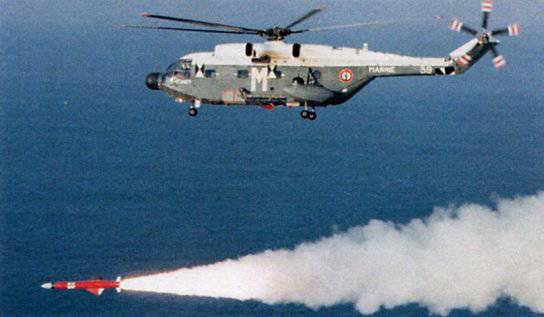
The first official flight of the “Super-Etandar” Air Force of Iraq took place on March 27 1984. At the same time, in the area of the Kharg oil terminal, a Greek tanker and a small auxiliary vessel were damaged.
From that moment on, the Iraqis began to fly rather intensely. They stated that the pilots of the "Super-Etandarov" conducted a 51 combat operation and in each case "destroyed a large naval target." True, the Lloyd's commercial fleet registry completely refutes this assertion. The Super Etandars served in the Iraqi Air Force until 1985, when the surviving vehicles (one was lost, another damaged under unclear circumstances, and the Iranian side stated that both vehicles were the victim of their fighters) were returned to France and replaced with French supersonic fighters. Mirage F1. And the French, it was announced that the lease term of the aircraft has expired, and allegedly all five cars returned to France. Iraq fully paid for their use and no questions about compensation for losses were raised.
The use of "Super-Etandarov" significantly reduced the export of Iranian oil. Entering into the taste, Saddam Hussein decided to get hold of his own "pocket rocket carriers". Therefore, of the Mirage F1979 (total 1 machines delivered) supplied by the French from 93 to Iraq at the end of 20, there was a modification of Mirage F1984EQ-1, which was a "hybrid" Mirage F5 with the Super Etendar sighting system based on the Radar "Agawa" , providing start-up PKR "Exocet".

3 December 1984, the pilot of the Mirage F1EQ-5, for the first time tried to use the anti-ship missile control AM.39 "Exochet", but the attack failed due to a failure in the guidance system. The first success was recorded 14 February 1985 g., When the rocket hit the tanker "Neptunia".
Since 12 August 1986, the raids on the terminal on. Sirri, lying in 240 km north of the Strait of Hormuz. Four Mirages, armed with Exesets, refueled in flight from the An-12 transport plane, covered the distance of 1300 km, attacked the complex and three tankers, and returned without loss to their airfield. The most impressive was the 25 raid of November 1987 of the year against Larak Island, which is located in the Strait of Hormuz. This mission was performed by the most experienced pilots. They overcame more than 4000 km at both ends, during the flight to the target they refueled in the air from An-12, and on the way back they made an intermediate landing in Saudi Arabia. At Larak, some terminal facilities were hit, and in the water area, several tankers. Later, the Mirages began to refuel in the air and from Iraqi-modified X-Numx transport vehicles.
Usually, the Exeset was hung on the Mirage under the fuselage, and only once, July 17 of the year 1987, were two such missiles suspended under the wing. It was Mirage F1EQ-5 that owned the Iraqi Air Force's most famous rocket attack: off the coast of Bahrain, a single Mirage, which was moving at a speed of 620 km / h at an altitude of 900 m, launched itself in 22 hours of 05 minutes from a distance of 20 km made a launch both "Execetes". The attacked ship turned out to be the American frigate URO "Stark" (FFG-31) of the type "Oliver H. Perry". Sailors did not have time to react to the threat. The first missile struck the frigate in the port side at the 100-th frame at the level of the second deck, above the waterline. Having punched a hole in the board with dimensions 3 × 4,5 m, the rocket hit the ship’s interior, but did not explode. With an interval of 25 seconds into the port side in the area of the 110 th frame, slightly above the point of impact of the first rocket, the frigate was struck by the second rocket, which exploded in the cabin staff officers. There was a fire that spread to the premises of the BIC. The main systems and mechanisms have lost electricity, “Stark” has lost speed and control. The struggle for the survival of the ship. The frigate remained afloat, but 37 Americans died, and 22 was injured. The bodies of the 35 crew members were sent to the US, two people are missing. American experts noted that if it were in the stormy Atlantic, and not in calm in the Persian Gulf, the frigate would inevitably have sank. Baghdad immediately apologized, saying that an unfortunate mistake had occurred. and the aircraft pilot took the frigate for the Iranian tanker. Saddam Hussein was then considered a “good guy,” and Iran was the main opponent of the United States in the region, so Washington accepted the explanation, and did not receive an incident. The Iraqi government has provided 400 with millions of dollars to compensate for prisoners of war, hostages, and among the injured sailors of the Stark frigate. However, when in 1990-s. the Iraqi pilot A. Salem began to talk about his exploits in the West, he said that he had planned the attack on purpose, and he was its immediate perpetrator.
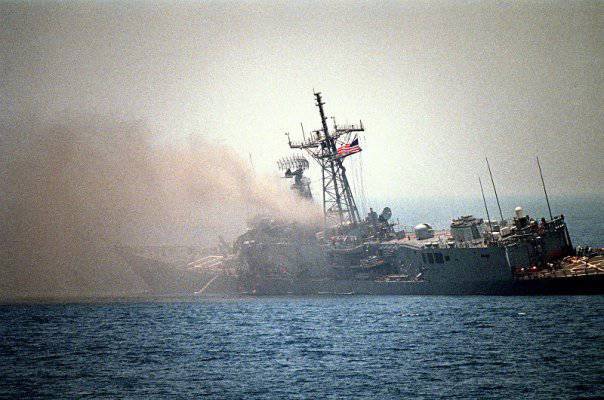
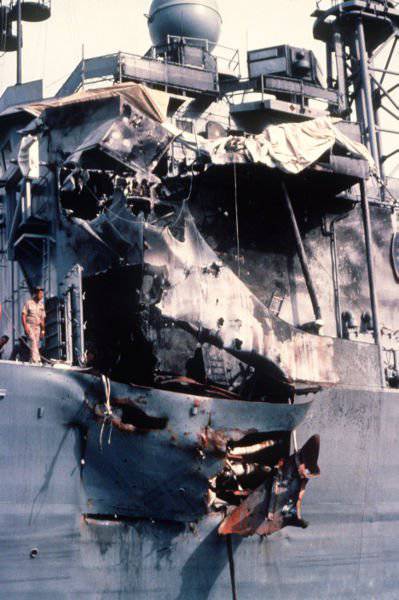
In total, until the end of the war, the Iraqi Mirages hit more than a hundred naval targets, while it was possible to sink or damage 57. Of these, 44 suffered from AM.39 "Exochet" hits, 8 from various free-falling bombs, 4 from adjustable and one from AS-30L.
Helicopters distinguished themselves and SA.321H "Super Frelon". At the end of September and November 1982, two Iranian warships were struck by "exosets" from them, but they were able to remain combat-ready. 4 September 1986 of the year SA.321H hit the Iranian coast guard ship near the Al-Omaeh oil platform with an “exosete”, the ship was able to lag behind. In addition, during the “tanker war”, “Super Frelons” more than 30 tankers and other transport vessels were sunk or destroyed and at least 20 was damaged.
The biggest battle of "Super Frelonov" by Saddam Hussein took place on July 1 1984. Under fire of their "exosets" six tankers fell at once. The first two exploded and were destroyed by fire, while the rest of the missiles were not hit, but they provoked a panic on four ships. What ultimately led to the fact that all four tankers in a panic just collided with each other. The next day, Super Frelon destroyed another tanker.
However, there were losses: two helicopters were destroyed by Iranian fighters. The first is July 12 1986. The helicopter landed on Al-Omaeh’s Iraqi oil platform for refueling, and the F-14A “Tomcat”, having no weapons capable of “working” on the ground, could do nothing with it. I had to call the Iranian F-4E Phantom II, armed with anti-tank missiles. From a direct hit by the AGM-65A “Maverick” rocket, the Super Frelon scattered into pieces. The second helicopter was shot down 24 June 1987, the Iranian F-14A. October 6 1986 Iranian F-14A fighter "maneuvered" the Iraqi Mirage F1EQ-5, driving it into the waters of the Persian Gulf.
The Iraqis also used the MiG-23BN set by the USSR against the Iranian ships, attacking them with free-falling bombs. So, September 24 1980, Iraqi MiG-23BN 250-kg bombed the Iranian corvette Naghdi Bayandor type with bombs.

History of the Iran-Iraq war at sea is extremely tangled and covered with mystery, it is only known that the Iraqis, in addition to the ships mentioned, lost 6 patrol ships of the PB 90 type, and the Iranians 2 corvette of the Bayandor type (Milanian-X / NNXX and Kahnamoie) / n 83), although there are allegations that they were sunk by anti-ship missiles P-84 from the Iraqi RCA project 15. However, who, what and when sank these ships, I personally do not know.
On the materials of the sites:
http://bintel.com.ua/ru/guests/print/voenno-morskie-sily-iraka3/
http://www.airwar.ru/index.html
http://topwar.ru/
http://www.militaryparitet.com/
http://forums.airbase.ru/
http://navyworld.narod.ru/index.html
http://russian-ships.info/
http://ryadovoy.ru/forum/index.php
http://waronline.org/mideast/iraq_navy.htm
Information